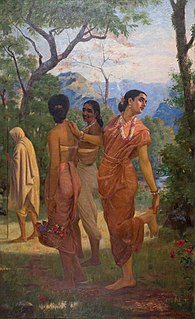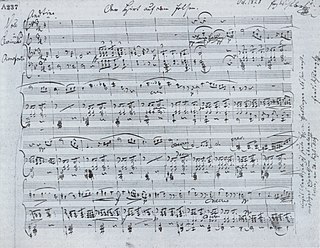
Sakuntala, also Sakontala, D 701, is an unfinished opera in three acts, written c. 1820 by Franz Schubert to a libretto by Johann Philipp Neumann. The opera is based on the Sanskrit story of Shakuntala's love for King Duschmanta and her rejection.

Sakuntala, also Sakontala, D 701, is an unfinished opera in three acts, written c. 1820 by Franz Schubert to a libretto by Johann Philipp Neumann. The opera is based on the Sanskrit story of Shakuntala's love for King Duschmanta and her rejection.
The work is for fourteen sopranos, three altos, five tenors, nine basses, mixed choir and orchestra.

Franz von Suppé was an Austrian composer of light operas and other theatre music. He came from the Kingdom of Dalmatia, Austro-Hungarian Empire. A composer and conductor of the Romantic period, he is notable for his four dozen operettas.

Abhijnanashakuntalam, also known as Shakuntala, The Recognition of Shakuntala, The Sign of Shakuntala, and many other variants, is a Sanskrit play by the ancient Indian poet Kālidāsa, dramatizing the story of Śakuntalā told in the epic Mahābhārata and regarded as best of Kālidāsa's works. Its exact date is uncertain, but Kālidāsa is often placed in the 4th century CE.

"The Shepherd on the Rock", D. 965, is a Lied for soprano, clarinet, and piano by Franz Schubert. It was composed in 1828 during the final months of his life.
Karl Aage Rasmussen is a Danish composer and writer.

Franz Adolf Friedrich Schober, since 1801 von Schober, was an Austrian poet, librettist, lithographer, actor in Breslau and Legationsrat in Weimar.

Der Zwerg is a lied for voice and piano by Franz Schubert, written in the mid-1820s on a text by Matthäus von Collin. The poem is in terza rima. In Otto Erich Deutsch's catalogue of Schubert's works, it is Op. 22, No. 1, D. 771.

Hermann Ritter was a German viola player, composer and music historian.

Johann Baptist Mayrhofer was an Austrian poet and librettist. He is best known for his close friendship with the composer Franz Schubert.

Franz Schubert (1797–1828): New Edition of the Complete Works, commonly known as the New Schubert Edition (NSE), or, in German: Neue Schubert-Ausgabe (NSA), is a complete edition of Franz Schubert's works, which started in 1956 and is scheduled to conclude in 2027. The projected number of volumes of the publication, which includes score editions, critical reports and supplements, is 177, of which, as of 2020, 150 have been realised.
Franz Schubert's best-known music for the theatre is his incidental music for Rosamunde. Less successful were his many opera and Singspiel projects. On the other hand, some of his most popular Lieder, like "Gretchen am Spinnrade," were based on texts written for the theatre.

Franz Schubert's best known song cycles, like Die schöne Müllerin and Winterreise are based on separate poems with a common theme and narrative. Other song cycles are based on consecutive excerpts of the same literary work: Schubert's "Ave Maria" is part of such a song cycle based on excerpts of the same poem, in this case by Walter Scott.

Lazarus or Die Feier der Auferstehung, D 689, is an unfinished 1820 oratorio by Franz Schubert on a libretto by August Hermann Niemeyer. Intended to be in three acts, only act 1 with twenty-one numbers, and eight numbers from act 2 are extant.

Der Graf von Gleichen D 918 is an unfinished 1827 opera in two acts by Franz Schubert after a libretto by Eduard Bauernfeld.

Die Freunde von Salamanka D.326 is an 1815 singspiel in two acts by Franz Schubert to a libretto by Johann Mayrhofer.

Der vierjährige Posten, D 190, is a one-act singspiel by Franz Schubert to a libretto by Theodor Körner written for Carl Steinacker's (1784–1814) opera of the same title that premiered in 1813 in Vienna's Theater an der Wien. Written in 1815 when Schubert was 18 years old, it was first performed on 23 September 1896, 67 years after Schubert's death, at the Dresden Court Opera.

"Gesang der Geister über den Wassern" is a 1779 poem by Johann Wolfgang von Goethe (1749–1832). It may be best known in the English-speaking world through a musical setting of 1820–21 by Franz Schubert (1797–1828) as a part song for men's voices and low strings (D.714).

Gottlob Benedict Bierey was a German composer, Kapellmeister and Theatre tenant.
Georg von Hofmann was an Austrian occasional poet.